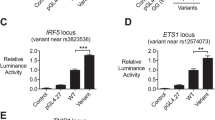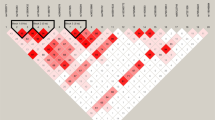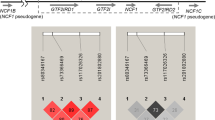Abstract
The tumor necrosis factor ligand superfamily member 4 gene (TNFSF4) encodes the OX40 ligand (OX40L), a costimulatory molecule involved in T-cell activation. A recent study demonstrated the association of TNFSF4 haplotypes located in the upstream region with risk for or protection from systemic lupus erythematosus (SLE). To replicate this association, five single nucleotide polymorphisms (SNPs) tagging the previously associated haplotypes and passing the proper quality-control filters were tested in 1312 cases and 1801 controls from Germany, Italy, Spain and Argentina. The association of TNFSF4 with SLE was replicated in all the sets except Spain. There was a unique risk haplotype tagged by the minor alleles of the SNPs rs1234317 (pooled odds ratio (OR)=1.39, P=0.0009) and rs12039904 (pooled OR=1.38, P=0.0012). We did not observe association to a single protective marker (rs844644) or haplotype as the first study reported; instead, we observed different protective haplotypes, all carrying the major alleles of both SNPs rs1234317 and rs12039904. Association analysis conditioning on the haplotypic background confirmed that these two SNPs explain the entire haplotype effect. This first replication study confirms the association of genetic variation in the upstream region of TNFSF4 with susceptibility to SLE.
This is a preview of subscription content, access via your institution
Access options
Subscribe to this journal
Receive 6 digital issues and online access to articles
$119.00 per year
only $19.83 per issue
Buy this article
- Purchase on Springer Link
- Instant access to full article PDF
Prices may be subject to local taxes which are calculated during checkout

Similar content being viewed by others
References
Graham DS, Graham RR, Manku H, Wong AK, Whittaker JC, Gaffney PM et al. Polymorphism at the TNF superfamily gene TNFSF4 confers susceptibility to systemic lupus erythematosus. Nat Genet 2008; 40: 83–89.
Prokunina L, Castillejo-Lopez C, Oberg F, Gunnarsson I, Berg L, Magnusson V et al. A regulatory polymorphism in PDCD1 is associated with susceptibility to systemic lupus erythematosus in humans. Nat Genet 2002; 32: 666–669.
Salmon JE, Millard S, Schachter LA, Arnett FC, Ginzler EM, Gourley MF et al. Fc gamma RIIA alleles are heritable risk factors for lupus nephritis in African Americans. J Clin Invest 1996; 97: 1348–1354.
Harley JB, Alarcon-Riquelme ME, Criswell LA, Jacob CO, Kimberly RP, Moser KL et al. Genome-wide association scan in women with systemic lupus erythematosus identifies susceptibility variants in ITGAM, PXK, KIAA1542 and other loci. Nat Genet 2008; 40: 204–210.
Hom G, Graham RR, Modrek B, Taylor KE, Ortmann W, Garnier S et al. Association of systemic lupus erythematosus with C8orf13-BLK and ITGAM-ITGAX. N Engl J Med 2008; 358: 900–909.
Sigurdsson S, Nordmark G, Goring HH, Lindroos K, Wiman AC, Sturfelt G et al. Polymorphisms in the tyrosine kinase 2 and interferon regulatory factor 5 genes are associated with systemic lupus erythematosus. Am J Hum Genet 2005; 76: 528–537.
Kozyrev SV, Lewén S, Linga Reddy MVP, Pons-Estel BA, Torsten W, Junker P et al. Structural insertion/deletion variation in IRF5 is associated with a risk haplotype and defines the precise isoforms expressed in SLE. Arthritis and Rheumatism 2007; 56: 1234–1241.
Graham RR, Kyogoku C, Sigurdsson S, Vlasova IA, Davies LR, Baechler EC et al. Three functional variants of IFN regulatory factor 5 (IRF5) define risk and protective haplotypes for human lupus. Proc Natl Acad Sci USA 2007; 104: 6758–6763.
Kozyrev SV, Abelson AK, Wojcik J, Zaghlool A, Linga Reddy MV, Sanchez E et al. Functional variants in the B-cell gene BANK1 are associated with systemic lupus erythematosus. Nat Genet 2008; 40: 211–216.
Remmers EF, Plenge RM, Lee AT, Graham RR, Hom G, Behrens TW et al. STAT4 and the risk of rheumatoid arthritis and systemic lupus erythematosus. N Engl J Med 2007; 357: 977–986.
Kyogoku C, Langefeld CD, Ortmann WA, Lee A, Selby S, Carlton VE et al. Genetic association of the R620W polymorphism of protein tyrosine phosphatase PTPN22 with human SLE. Am J Hum Genet 2004; 75: 504–507.
Orozco G, Sanchez E, Gonzalez-Gay MA, Lopez-Nevot MA, Torres B, Caliz R et al. Association of a functional single-nucleotide polymorphism of PTPN22, encoding lymphoid protein phosphatase, with rheumatoid arthritis and systemic lupus erythematosus. Arthritis Rheum 2005; 52: 219–224.
Graham RR, Cotsapas C, Davies L, Hackett R, Lessard CJ, Leon JM et al. Genetic variants near TNFAIP3 on 6q23 are associated with systemic lupus erythematosus. Nat Genet 2008; 40: 1059–1061.
Musone SL, Taylor KE, Lu TT, Nititham J, Ferreira RC, Ortmann W et al. Multiple polymorphisms in the TNFAIP3 region are independently associated with systemic lupus erythematosus. Nat Genet 2008; 40: 1059–1061.
Ito T, Amakawa R, Inaba M, Hori T, Ota M, Nakamura K et al. Plasmacytoid dendritic cells regulate Th cell responses through OX40 ligand and type I IFNs. J Immunol 2004; 172: 4253–4259.
Ito T, Wang YH, Duramad O, Hanabuchi S, Perng OA, Gilliet M et al. OX40 ligand shuts down IL-10-producing regulatory T cells. Proc Natl Acad Sci USA 2006; 103: 13138–13143.
Purcell S, Neale B, Todd-Brown K, Thomas L, Ferreira MA, Bender D et al. PLINK: a tool set for whole-genome association and population-based linkage analyses. Am J Hum Genet 2007; 81: 559–575.
Frazer KA, Ballinger DG, Cox DR, Hinds DA, Stuve LL, Gibbs RA et al. A second generation human haplotype map of over 3.1 million SNPs. Nature 2007; 449: 851–861.
Ferreiros-Vidal I, Gomez-Reino JJ, Barros F, Carracedo A, Carreira P, Gonzalez-Escribano F et al. Association of PDCD1 with susceptibility to systemic lupus erythematosus: evidence of population-specific effects. Arthritis Rheum 2004; 50: 2590–2597.
Thorburn CM, Prokunina-Olsson L, Sterba KA, Lum RF, Seldin MF, Alarcon-Riquelme ME et al. Association of PDCD1 genetic variation with risk and clinical manifestations of systemic lupus erythematosus in a multiethnic cohort. Genes Immun 2007; 8: 279–287.
Kaufman KM, Kelly JA, Herring BJ, Adler AJ, Glenn SB, Namjou B et al. Evaluation of the genetic association of the PTPN22 R620W polymorphism in familial and sporadic systemic lupus erythematosus. Arthritis Rheum 2006; 54: 2533–2540.
Lee YH, Rho YH, Choi SJ, Ji JD, Song GG, Nath SK et al. The PTPN22 C1858T functional polymorphism and autoimmune diseases—a meta-analysis. Rheumatology (Oxford) 2007; 46: 49–56.
Aguilar F, Torres B, Sanchez-Roman J, Nunez-Roldan A, Gonzalez-Escribano MF . CTLA4 polymorphism in Spanish patients with systemic lupus erythematosus. Hum Immunol 2003; 64: 936–940.
Barreto M, Santos E, Ferreira R, Fesel C, Fontes MF, Pereira C et al. Evidence for CTLA4 as a susceptibility gene for systemic lupus erythematosus. Eur J Hum Genet 2004; 12: 620–626.
Graham DS, Wong AK, McHugh NJ, Whittaker JC, Vyse TJ . Evidence for unique association signals in SLE at the CD28-CTLA4-ICOS locus in a family-based study. Hum Mol Genet 2006; 15: 3195–3205.
Torres B, Aguilar F, Franco E, Sanchez E, Sanchez-Roman J, Jimenez Alonso J et al. Association of the CT60 marker of the CTLA4 gene with systemic lupus erythematosus. Arthritis Rheum 2004; 50: 2211–2215.
Moser KL, Neas BR, Salmon JE, Yu H, Gray-McGuire C, Asundi N et al. Genome scan of human systemic lupus erythematosus: evidence for linkage on chromosome 1q in African-American pedigrees. Proc Natl Acad Sci USA 1998; 95: 14869–14874.
Johanneson B, Lima G, von Salome J, Alarcon-Segovia D, Alarcon-Riquelme ME . A major susceptibility locus for systemic lupus erythemathosus maps to chromosome 1q31. Am J Hum Genet 2002; 71: 1060–1071.
Ikushima S, Inukai T, Inaba T, Nimer SD, Cleveland JL, Look AT . Pivotal role for the NFIL3/E4BP4 transcription factor in interleukin 3-mediated survival of pro-B lymphocytes. Proc Natl Acad Sci USA 1997; 94: 2609–2614.
Kuribara R, Kinoshita T, Miyajima A, Shinjyo T, Yoshihara T, Inukai T et al. Two distinct interleukin-3-mediated signal pathways, Ras-NFIL3 (E4BP4) and Bcl-xL, regulate the survival of murine pro-B lymphocytes. Mol Cell Biol 1999; 19: 2754–2762.
Tan EM, Cohen AS, Fries JF, Masi AT, McShane DJ, Rothfield NF et al. The 1982 revised criteria for the classification of systemic lupus erythematosus. Arthritis Rheum 1982; 25: 1271–1277.
Barrett JC, Fry B, Maller J, Daly MJ . Haploview: analysis and visualization of LD and haplotype maps. Bioinformatics 2005; 21: 263–265.
Acknowledgements
This work was supported by the Swedish Research Council, the Gustav-Ve-80-year Jubilee Foundation, the Torsten and Ragnar Söderbegs Foundation, the Marcus Borgströms Foundation and the Swedish Association Against Rheumatism. MEAR is supported by an award from the Knut and Alice Wallenberg Foundation through the Royal Swedish Academy of Sciences. This work was also partially supported by PRIN Project (MIUR, Rome), Compagnia di San Paolo (Turin), Regione Piemonte (Ricerca Sanitaria Finalizzata Project and Ricerca Sanitaria Applicata-CIPE Project), Fondazione Monte dei Paschi di Siena, the BMBF Kompetenznetz Rheuma C2.12 (Germany), Plan Nacional de I+D (Spain, SAF06-00398) and Grant CTS1880 (Junta de Andalucía, Spain). We thank Adriana I Scollo, Armando M Perichon and Mariano CR Tenaglia (CEDIM, Diagnóstico Molecular y Forense SRL, Rosario, Argentina), for their help in preparing the Argentinean samples.
The Argentine collaborative group participants: Hugo R Scherbarth MD, Jorge A Lopez MD, Estela L Motta MD Servicio de Reumatología, Hospital Interzonal General de Agudos ‘Dr Oscar Alende’, Mar del Plata, Argentina; Susana Gamron MD, Sandra Buliubasich MD, Emilia Menso MD Servicio de Reumatología de la UHMI 1, Hospital Nacional de Clínicas, Universidad Nacional de Córdoba, Córdoba, Argentina; Alberto Allievi MD, Jose L Presas MD Hospital General de Agudos Dr Juán A Fernandez, Buenos Aires, Argentina; Guillermo A Tate MD Organización Médica de Investigación, Buenos Aires, Argentina; Simon A Palatnik MD, Mariela Bearzotti PhD Facultad de Ciencias Médicas, Universidad Nacional de Rosario y Hospital Provincial del Centenario, Rosario, Argentina; Alejandro Alvarellos MD, Francisco Caeiro MD, Ana Bertoli MD Servicio de Reumatología, Hospital Privado, Centro Médico de Córdoba, Córdoba, Argentina; Sergio Paira MD, Susana Roverano MD, Carlos Louteiro MD Hospital José M Cullen, Santa Fe, Argentina; Cesar E Graf MD, Estela Bertero PhD Hospital San Martín, Paraná; Cesar Caprarulo MD, Griselda Buchanan PhD Hospital Felipe Heras, Concordia, Entre Ríos, Argentina; Carolina Guillerón MD, Sebastian Grimaudo PhD, Jorge Manni MD Departamento de Inmunología, Instituto de Investigaciones Médicas ‘Alfredo Lanari’, Buenos Aires, Argentina; Luis J Catoggio MD, Enrique R Soriano MD, Carlos D Santos MD Sección Reumatología, Servicio de Clínica Médica, Hospital Italiano de Buenos Aires y Fundación Dr Pedro M Catoggio para el Progreso de la Reumatología, Buenos Aires, Argentina; Cristina Prigione MD, Fernando A Ramos MD, Sandra M Navarro MD Servicio de Reumatología, Hospital Provincial de Rosario, Rosario, Argentina; Guillermo A Berbotto MD, Marisa Jorfen MD, Elisa J Romero PhD Servicio de Reumatología Hospital Escuela Eva Perón Granadero Baigorria, Rosario, Argentina; Mercedes A Garcia MD, Juan C Marcos MD, Ana I Marcos MD Servicio de Reumatología, Hospital Interzonal General de Agudos General San Martín, La Plata; Carlos E Perandones MD, Alicia Eimon MD Centro de Educación Médica e Investigaciones Clínicas (CEMIC), Buenos Aires, Argentina; Cristina G Battagliotti MD Hospital de Niños Dr Orlando Alassia, Santa Fe, Argentina.
The German collaborative group participants: K Armadi-Simab, MD, Wolfgang L Gross, MD, Abteilung Rheumatologie und Immunologie, University Hospital of Schleswig-Holstein, Campus Luebeck, Rheumaklinik Bad Bramstedt, Luebeck, Germany, Erika Gromnica-Ihle, MD, Rheumaklinik Berlin-Buch, Berlin, Germany, Hans-Hartmut Peter, MD, Medizinische Universitaetsklinik, Abteilung Rheumatologie und Klinische Immunologie, Freiburg, Germany, Karin Manger, MD, Medizinische Klinik III derFAU Erlangen-Nuernberg, Erlangen, Germany, Sebastian Schnarr, MD, Henning Zeidler, MD, Abteilung Rheumatologie, Medizinische Hochschule Hannover, Hannover, Germany, Reinhold E Schmidt, MD, Klinik fuer Immunologie und Rheumatologies, Medizinische Hochschule Hannover, Hannover, Germany.
The Spanish collaborative group participants: Norberto Ortego, Servicio Medicina Interna, Hospital Clínico San Cecilio, Granada, Enrique de Ramón, Servicio de Medicina Interna, Hospital Carlos Haya, Málaga, Juan Jiménez-Alonso, Servicio de Medicina Interna, Hospital Virgen de las Nieves, Granada, Julio Sánchez-Román, Servicio de Medicina Interna, Hospital Virgen del Rocío, Sevilla, and Miguel ángel López-Nevot, Servicio de Inmunología, Hospital Virgen de las Nieves, Granada.
The Italian collaborative group participants: Maria Giovanna Danieli and Armando Gabrielli (Clinica Medica, Dipartimento di Scienze Mediche e Chirurgiche, Università Politecnica delle Marche, Ancona, Italy), Gian Domenico Sebastiani (UOC di Reumatologia Ospedale San Camillo, Roma – Italy), Patrizia Rovere Querini (IRCCS San Raffaele Scientific Institute, Milan, Italy), Sergio Migliaresi (Rheumatology Unit Second University of Naples, Naples, Italy).
Author information
Authors and Affiliations
Corresponding author
Additional information
Supplementary Information accompanies the paper on Genes and Immunity website (http://www.nature.com/gene)
Supplementary information
Rights and permissions
About this article
Cite this article
Delgado-Vega, A., Abelson, AK., Sánchez, E. et al. Replication of the TNFSF4 (OX40L) promoter region association with systemic lupus erythematosus. Genes Immun 10, 248–253 (2009). https://doi.org/10.1038/gene.2008.95
Received:
Accepted:
Published:
Issue Date:
DOI: https://doi.org/10.1038/gene.2008.95
Keywords
This article is cited by
-
Association of TNFSF4 polymorphisms with systemic lupus erythematosus: a meta-analysis
Advances in Rheumatology (2021)
-
TNFSF4 is a risk factor to systemic lupus erythematosus in a Latin American population
Clinical Rheumatology (2021)
-
Whole Exome Sequencing of Patients from Multicase Families with Systemic Lupus Erythematosus Identifies Multiple Rare Variants
Scientific Reports (2018)
-
Association of TNFSF4 Polymorphisms with Vogt-Koyanagi-Harada and Behcet’s Disease in Han Chinese
Scientific Reports (2016)
-
The Genetics of Scleroderma
Current Rheumatology Reports (2011)



